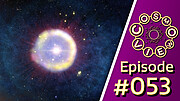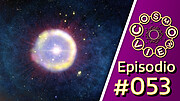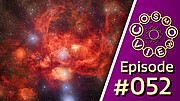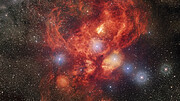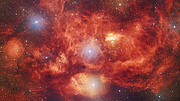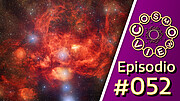PR Image eso2212c
The Milky Way and the location of its central black hole as viewed from the Atacama Large Millimeter/submillimeter Array
PR Image eso2212e
Sagittarius A* in the constellation of Sagittarius
Videos
PR Video eso2212a
Hot Gas Bubble Swirling Around our Supermassive Black Hole (ESOcast 256 Light) 
Sagittarius A* and animation of the hot spot around it
Using the Atacama Large
Millimeter/submillimeter Array (ALMA), astronomers have spotted signs of
a ‘hot spot’ orbiting Sagittarius A*, the black hole at the centre of
our galaxy. The finding helps us better understand the enigmatic and
dynamic environment of our supermassive black hole.
“We think we're looking at a hot bubble of gas zipping
around Sagittarius A* on an orbit similar in size to that of the planet
Mercury, but making a full loop in just around 70 minutes. This requires
a mind blowing velocity of about 30% of the speed of light!” says Maciek Wielgus of the Max Planck Institute for Radio Astronomy in Bonn, Germany, who led the study published today in Astronomy & Astrophysics.
The observations were made with ALMA in the Chilean Andes —
a radio telescope co-owned by the European Southern Observatory (ESO) —
during a campaign by the Event Horizon Telescope (EHT) Collaboration to
image black holes. In April 2017 the EHT linked together eight existing
radio telescopes worldwide, including ALMA, resulting in the recently released first ever image of Sagittarius A*.
To calibrate the EHT data, Wielgus and his colleagues, who are members
of the EHT Collaboration, used ALMA data recorded simultaneously with
the EHT observations of Sagittarius A*. To the team's surprise, there
were more clues to the nature of the black hole hidden in the ALMA-only
measurements.
By chance, some of the observations were done shortly after
a burst or flare of X-ray energy was emitted from the centre of our
galaxy, which was spotted by NASA’s Chandra Space Telescope.
These kinds of flares, previously observed with X-ray and infrared
telescopes, are thought to be associated with so-called ‘hot spots’, hot
gas bubbles that orbit very fast and close to the black hole.
“What is really new and interesting is that such flares
were so far only clearly present in X-ray and infrared observations of
Sagittarius A*. Here we see for the first time a very strong indication
that orbiting hot spots are also present in radio observations,”
says Wielgus, who is also affiliated with the Nicolaus Copernicus
Astronomical Centre, Poland and the Black Hole Initiative at Harvard
University, USA.
“Perhaps these hot spots detected at infrared
wavelengths are a manifestation of the same physical phenomenon: as
infrared-emitting hot spots cool down, they become visible at longer
wavelengths, like the ones observed by ALMA and the EHT,” adds Jesse Vos, a PhD student at Radboud University, the Netherlands, who was also involved in this study.
The flares were long thought to originate from magnetic
interactions in the very hot gas orbiting very close to Sagittarius A*,
and the new findings support this idea. “Now we find strong evidence for
a magnetic origin of these flares and our observations give us a clue
about the geometry of the process. The new data are extremely helpful
for building a theoretical interpretation of these events,” says
co-author Monika Mościbrodzka from Radboud University.
ALMA allows astronomers to study polarised
radio emission from Sagittarius A*, which can be used to unveil the
black hole’s magnetic field. The team used these observations together
with theoretical models to learn more about the formation of the hot
spot and the environment it is embedded in, including the magnetic field
around Sagittarius A*. Their research provides stronger constraints on
the shape of this magnetic field than previous observations, helping
astronomers uncover the nature of our black hole and its surroundings.
The observations confirm some of the previous discoveries made by the GRAVITY instrument at ESO’s Very Large Telescope
(VLT), which observes in the infrared. The data from GRAVITY and ALMA
both suggest the flare originates in a clump of gas swirling around the
black hole at about 30% of the speed of light in a clockwise direction
in the sky, with the orbit of the hot spot being nearly face-on.
“In the future we should be able to track hot spots
across frequencies using coordinated multiwavelength observations with
both GRAVITY and ALMA — the success of such an endeavour would be a true
milestone for our understanding of the physics of flares in the
Galactic centre,” says Ivan Marti-Vidal of the University of València in Spain, co-author of the study.
The team is also hoping to be able to directly observe the
orbiting gas clumps with the EHT, to probe ever closer to the black hole
and learn more about it. “Hopefully, one day, we will be comfortable saying that we ‘know’ what is going on in Sagittarius A*,” Wielgus concludes.
More Information This research was presented in the paper “Orbital motion
near Sagittarius A* – Constraints from polarimetric ALMA observations”
to appear in Astronomy Astrophysics (https://www.aanda.org/10.1051/0004-6361/202244493).
The team is composed of M. Wielgus (Max-Planck-Institut für
Radioastronomie, Germany [MPIfR]; Nicolaus Copernicus Astronomical
Centre, Polish Academy of Sciences, Poland; Black Hole Initiative at
Harvard University, USA [BHI]), M. Moscibrodzka (Department of
Astrophysics, Radboud University, The Netherlands [Radboud]), J. Vos
(Radboud), Z. Gelles (Center for Astrophysics | Harvard
Smithsonian, USA and BHI), I. Martí-Vidal (Universitat de València,
Spain), J. Farah (Las Cumbres Observatory, USA; University of
California, Santa Barbara, USA), N. Marchili (Italian ALMA Regional
Centre, INAF-Istituto di Radioastronomia, Italy and MPIfR), C. Goddi
(Dipartimento di Fisica, Università degli Studi di Cagliari, Italy and
Universidade de São Paulo, Brazil), and H. Messias (Joint ALMA
Observatory, Chile).
The Atacama Large Millimeter/submillimeter Array (ALMA), an
international astronomy facility, is a partnership of ESO, the U.S.
National Science Foundation (NSF) and the National Institutes of Natural
Sciences (NINS) of Japan in cooperation with the Republic of Chile.
ALMA is funded by ESO on behalf of its Member States, by NSF in
cooperation with the National Research Council of Canada (NRC) and the
Ministry of Science and Technology (MOST) and by NINS in cooperation
with the Academia Sinica (AS) in Taiwan and the Korea Astronomy and
Space Science Institute (KASI). ALMA construction and operations are led
by ESO on behalf of its Member States; by the National Radio Astronomy
Observatory (NRAO), managed by Associated Universities, Inc. (AUI), on
behalf of North America; and by the National Astronomical Observatory of
Japan (NAOJ) on behalf of East Asia. The Joint ALMA Observatory (JAO)
provides the unified leadership and management of the construction,
commissioning and operation of ALMA.
The European Southern Observatory (ESO) enables scientists worldwide
to discover the secrets of the Universe for the benefit of all. We
design, build and operate world-class observatories on the ground —
which astronomers use to tackle exciting questions and spread the
fascination of astronomy — and promote international collaboration in
astronomy. Established as an intergovernmental organisation in 1962,
today ESO is supported by 16 Member States (Austria, Belgium, the Czech
Republic, Denmark, France, Finland, Germany, Ireland, Italy, the
Netherlands, Poland, Portugal, Spain, Sweden, Switzerland and the United
Kingdom), along with the host state of Chile and with Australia as a
Strategic Partner. ESO’s headquarters and its visitor centre and
planetarium, the ESO Supernova, are located close to Munich in Germany,
while the Chilean Atacama Desert, a marvellous place with unique
conditions to observe the sky, hosts our telescopes. ESO operates three
observing sites: La Silla, Paranal and Chajnantor. At Paranal, ESO
operates the Very Large Telescope and its Very Large Telescope
Interferometer, as well as two survey telescopes, VISTA working in the
infrared and the visible-light VLT Survey Telescope. Also at Paranal ESO
will host and operate the Cherenkov Telescope Array South, the world’s
largest and most sensitive gamma-ray observatory. Together with
international partners, ESO operates APEX and ALMA on Chajnantor, two
facilities that observe the skies in the millimetre and submillimetre
range. At Cerro Armazones, near Paranal, we are building “the world’s
biggest eye on the sky” — ESO’s Extremely Large Telescope. From our
offices in Santiago, Chile we support our operations in the country and
engage with Chilean partners and society.
Links
Contacts:
Maciek Wielgus
Max Planck Institute for Radio Astronomy
Bonn, Germany
Tel: +48 602417268
Email: maciek.wielgus@gmail.com
Monika Mościbrodzka
Radboud University
Nijmegen, The Netherlands
Tel: +31-24-36-52485
Email: m.moscibrodzka@astro.ru.nl
Ivan Martí Vidal
University of Valencia
Valencia, Spain
Tel: +34 963 543 078
Email: i.marti-vidal@uv.es
Jesse Vos
Radboud University
Nijmegen, The Netherlands
Cell: +31 6 34008019
Email: jt.vos@astro.ru.nl
Bárbara Ferreira
ESO Media Manager
Garching bei München, Germany
Cell: +49 151 241 664 00
Email: press@eso.org






